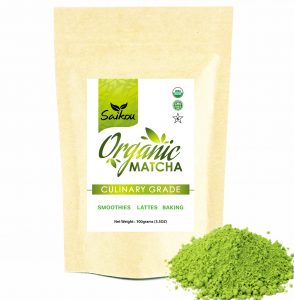
| Product Name | Organic Culinary Grade Matcha |
| Grade | Organic Culinary Grade |
| Origin | China |
| Size | 100 grams | about 3.5oz |
| Usage | Drinks / Baking / Weight loss |
How the Organic Culinary Grade Matcha is Produced ( The most economical grade)
1. Matcha Tea Leaves are Grown on a Tea Farm
When the tea buds grow. Tea fields are covered with black sheets to block out the sunlight. Shielding sunlight inhibits theanine, the flavor component, It also generates the sweet flavor unique to matcha, and the vivid green color.
2. Matcha Leaves are Harvested from the Spring to Summer
Culinary grade matcha leaves are harvested from spring to summer , from the top young tea leaves after the second time black sheets covered every year.
3. Matcha Leaves Are Steamed, Not Roasted
Picked tea buds are delivered to the processing factory. High-temperature steaming stunts the fermentation enzyme activities and retains the vivid green color of tea.
Culinary grade: Tea leaf is refined in a process of size- sorting, air sorting, re-drying .
4. Steamed Leaves are Laid Out to Dry then Ground into Powder
Refined tencha is delivered to the matcha factory. Micron-sized matcha is produced using tea grinders in a manufacturing room under constant temperature.
Culinary grade matcha is ground to small piece by grinder first and then ground by high pressure air flow( a technology from Japan) . in this way to increase the production of matcha and maintain the quality.
5. Packaging and shipping
Ground matcha is packed after final inspection. Only products which pass the final inspection are kept fresh and delivered to customers.